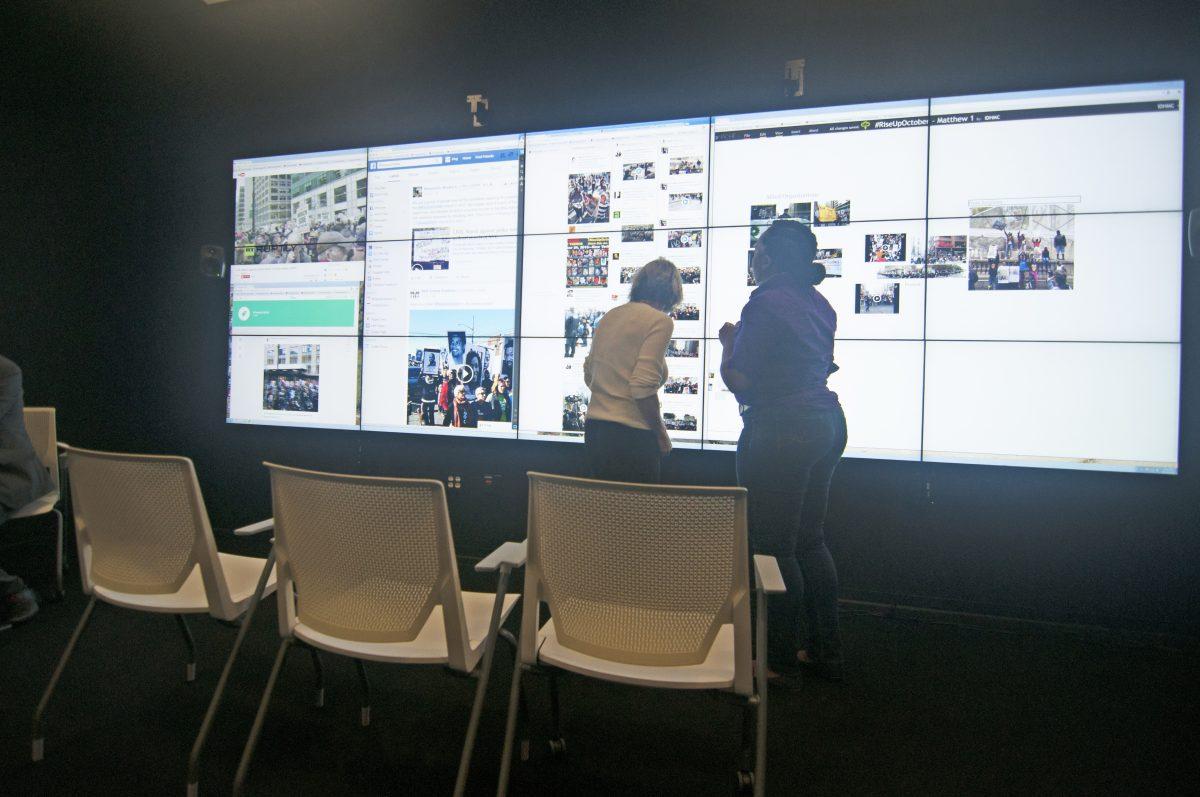Massive monitors covered the wall of room 433 in the Liberal Arts Building Saturday, live-streaming social media from a series of marches protesting police brutality in New York City.
#RiseUpOctober is a hashtag surrounding a number of marches held in New York City Thursday through Sunday. The marches were started by Cornel West and Carl Dix, founders of the “Stop Mass Incarceration Network,” in protest of police brutality in the United States.
The Initiative for Digital Humanities, Media and Culture partnered with the Office of Instructional and Research Computing and the Interface Ecology Lab to host “#RiseUpOctober: Engage and Build the Archive” Saturday. A&M researchers used the Humanities Visualization Space, a large wall of monitors that display social media feeds, to collect data on how people were interacting with the marches via social media.
Liz Gurmbach, research associate and project manager for the event, said the use of social media allowed West and Dix to speak to the world.
“I think it gives movements a voice — it allows them to get the message out that they’re trying to send,” Gurmbach said. “I’m most interested in the social movements because you see great things being done with social media, like different voices, experiences and perspectives that we could have never
seen before.”
Gurmbach said the social media aspect of the event reaches out to students in Texas in a way that allows them to be a part of the action.
“We wanted this to be a place where people could come in and experience the event in real time as it happens,” Gurmbach said.
Stephen Balfour, director of information technology for the College of Liberal Arts, said social media is the prime way for people on the ground during protests to communicate with the world and with one another.
“In many cases … there was no way to get the message out to others at the time,” Balfour said. “It gives people on the ground voices like they never had before. It also helps with organization — like if there is a danger in the community or someone encounters a problem, someone can send out a signal to warn others on the ground.”
Balfour said social media plays a much bigger role in society than people may realize.
“We want to figure out, ‘What is the role of social media in these kind of movements?’” Balfour said. “Many people argue social media is just this fun thing that has no societal impact, but it is so much more than that.”
Ajit Jain, a member of the Interface Ecology Lab, said the researchers involved wanted to study interaction on Twitter, Vine, Facebook, Instagram, UStream and other social media sites to see the different contexts of the event.
“Each medium has its own unique portrayal of the event — whether it be text, images or videos,” Jain said. “They all have their own strengths and putting them together we see everything going on, and we are able to watch simultaneously to help understand a larger perspective.”
The protests in New York aligned with a congressional hearing on the topic of police violence. Collette Flanagan, founder of Mothers Against Police Brutality, was in Washington D.C. this weekend to attend the hearing. Flanagan’s son, Clinton Allen, was shot on March 10, 2013 by a police officer.
“There are many different families that are going to be there, each with their own testimonies,” Flanagan said. “It’s a problem we’ve been dealing with since the 50s.”
Flanagan said the #RiseUpOctober hashtag is an example of social media’s impact on movements.
“Without [social media], we wouldn’t know a third of the things that are going on and there wouldn’t be this spotlight on police brutality,” Flanagan said.




















